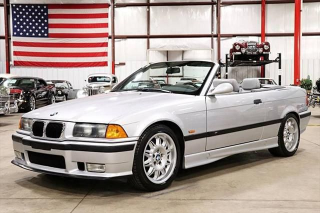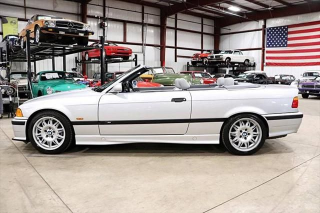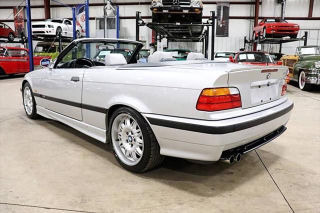The Good
The 1999 BMW M3 offers a compelling blend of advantages. Its legendary inline-six engine delivers thrilling performance and an engaging driving experience, appealing to emotional buyers. Practically, it boasts a timeless design, surprisingly comfortable and well-built interior, and decent daily usability. If properly maintained, reliability is strong, and its growing classic status means good long-term value.
The Bad
Prospective 1999 BMW M3 owners should be aware of a few common weaknesses. Key areas to watch out for include the cooling system (radiator, water pump, thermostat housing), potential VANOS unit issues, and deteriorating suspension components like rear shock mounts. Neglected maintenance is a major red flag, often leading to more significant and costly repairs.
1999 BMW M3: Quick Overview
The 1999 BMW M3, specifically the US-market E36 generation, came with a highly acclaimed powertrain and a suite of performance-oriented features.
- Engine: US models featured the S52B32, a 3.2-liter naturally aspirated inline-six engine.
- Horsepower: This engine produced 240 horsepower at 6,000 rpm and 236 lb-ft of torque at 3,800 rpm.
- Transmission: Typically paired with a 5-speed manual transmission, though a 5-speed automatic was also an option.
- Fuel Economy: EPA estimates for the manual transmission were approximately 18 MPG in the city and 26 MPG on the highway. Automatic versions saw slightly lower figures.
- 0-60 MPH: Manual transmission models could achieve 0-60 mph in the range of 5.5 to 6.0 seconds, depending on conditions and driver skill, which was impressive for its era.
- Towing Capacity: The BMW M3 was not rated or recommended for towing purposes. Its design is solely focused on performance driving.
- Trim-Level Features:
- Chassis: M-tuned suspension, including specific springs, shocks, and anti-roll bars, along with a revised steering rack for sharper response.
- Brakes: Larger, ventilated disc brakes at all four corners for enhanced stopping power.
- Exterior: Aerodynamic M-specific body kit, including unique front and rear bumpers, side skirts, and distinctive M mirrors.
- Wheels: Standard 17-inch alloy wheels.
- Interior: Sport seats with enhanced bolstering, M-Sport leather-wrapped steering wheel, M-badged instrument cluster, and unique interior trim.
- Drivetrain: A limited-slip differential was standard, optimizing power delivery to the rear wheels.
- Standard Comfort & Convenience: Automatic climate control, power windows, power locks, power mirrors, and a premium AM/FM/cassette stereo system were typical.
- Optional Features: Included heated front seats, cruise control, an on-board computer, a power sunroof (coupe), and an upgraded Harman Kardon sound system.
1999 BMW M3 Specifications
Vehicle Information
| Year | 1999 |
| Make | BMW |
| Model | M3 |
| Trim | - |
| Style | Coupe |
| Type | Coupe |
| Category | Minicompact Car |
Manufacturing Details
| Made In | Germany |
| Manufacturing City | REGENSBURG |
Dimensions
| Doors | 2-Door |
| Curb Weight | 3560 pounds |
| Gross Vehicle Weight Rating | - |
| Overall Height | 52.60 inches |
| Overall Length | 174.50 inches |
| Overall Width | 67.30 inches |
| Wheelbase Length | 106.30 inches |
| Standard Seating | 5 |
Engine & Performance
| Engine | 3.2-L L-6 DOHC 24V |
| Engine Size | 3.2L |
| Engine Cylinders | 6 |
| Transmission | 5-Speed Manual |
| Transmission Type | Manual |
| Transmission Speeds | 5-Speed |
| Drivetrain | Rear-Wheel Drive |
Additional Features
| Anti-Brake System | 4-Wheel ABS |
| Steering Type | Rack & Pinion |
Pricing
| Manufacturer Suggested Retail Price (MSRP) | $39,700 |
| Invoice Price | $34,955 |
| Delivery Charges | - |
Vehicle History Report
Specifications
History
Events
History Check
Check
Check
Check
Check
Listings
Recalls
Check
Analysis
What Problems Does the 1999 BMW M3 Have?
The 1999 BMW M3, while generally robust, does have several frequently reported problems and long-term reliability concerns that prospective owners should be aware of. Addressing these proactively is crucial for sustained performance and reliability.
- Cooling System: This is arguably the most common and critical weak point. Components like the plastic radiator, water pump (with a plastic impeller), thermostat housing, and various hoses are prone to failure due to age and heat cycling. Overheating can lead to costly engine damage. Regular inspection and preventative replacement are highly recommended.
- VANOS Unit: BMW's variable valve timing system (VANOS) on the S52 engine can develop issues. Symptoms include a rattling noise from the front of the engine, rough idle, and a reduction in power or fuel economy. Rebuilding or replacing the unit is a common repair.
- Suspension and Bushings: Over time, rubber components throughout the suspension system, such as control arm bushings (front and rear), trailing arm bushings (RTABs), and rear shock mounts, wear out. This can lead to clunking noises, imprecise handling, and uneven tire wear. Upgraded aftermarket parts are popular for longevity.
- Window Regulators: Failures of the power window regulators are a relatively common annoyance, leading to windows not moving or getting stuck.
- Oil Leaks: Valve cover gaskets, oil pan gaskets, and power steering hoses can develop leaks with age, requiring attention.
- Subframe/Differential Mounts: While less common than on the successor E46 M3, rear subframe mounting points and differential mounts can still crack or separate, especially on cars driven hard or experiencing significant abuse. Inspection during pre-purchase is vital.
- Rust: As an older vehicle, rust can be an issue, particularly in areas with road salt. Check wheel arches, rocker panels, and suspension mounting points.
Recalls: Several recalls affected BMW models of this era. A significant one includes the Takata airbag recall, which could impact the 1999 M3. Owners should check the NHTSA website using the VIN for any outstanding recalls. Other, less critical recalls might have addressed minor electrical or fuel system components. Long-term reliability is excellent if a meticulous maintenance schedule is followed; neglect, however, can quickly turn an M3 into a money pit.
How long will the 1999 BMW M3 last?
The 1999 BMW M3 is renowned for its long-term durability, with many examples comfortably exceeding 150,000 to 200,000 miles, and well-maintained cars often reaching 250,000 miles or more. Its core mechanical components, particularly the S52 inline-six engine and robust drivetrain, are exceptionally durable provided they receive consistent and preventative maintenance. Owners who adhere to diligent service schedules, especially concerning oil changes and addressing common weak points, can expect many years of thrilling driving.
However, weaknesses emerge with age. The plastic components of the cooling system remain a perennial concern, demanding proactive replacement. Rubber bushings and seals throughout the suspension and engine bay inevitably degrade, requiring replacement to maintain optimal handling and prevent leaks. Electrical components like window regulators and HVAC blower motors can fail. Interior elements such as seat bolsters and headliners can also show significant wear over two decades. Rust also becomes a factor in harsher climates. Overall, it's a durable vehicle that requires ongoing, specialized attention to truly last.
What Technology & Safety Features are Included?
The 1999 BMW M3, a product of its era, featured technology focused more on the driving experience than digital connectivity. Its built-in tech and entertainment reflected late-90s standards, prioritizing driver involvement.
- Built-in Tech: The primary piece of "tech" was the optional On-Board Computer (OBC), which offered functions like external temperature, fuel range, average speed, and a basic trip computer. It lacked the integrated navigation or advanced digital displays common in modern cars.
- Entertainment: Standard entertainment included an AM/FM stereo with a cassette player. An optional trunk-mounted CD changer was available, as was an upgraded Harman Kardon premium sound system, which provided superior audio quality for the time. Power antenna was also a common feature.
- Driver-Assistance Features: True driver-assistance systems as we know them today were absent. However, the M3 did incorporate fundamental active safety features:
- Anti-lock Braking System (ABS): Standard, preventing wheel lock-up during hard braking.
- Automatic Stability Control + Traction (ASC+T): This system helped prevent wheelspin and maintain stability by reducing engine power or applying individual brakes, though it could be manually de-activated by enthusiasts.
- Power Steering: Speed-sensitive power steering provided optimal feel at various speeds.
- Cruise Control: An optional feature for highway driving.
- Safety Features:
- Airbags: Dual front airbags were standard. Side airbags for front occupants became standard or optionally available on later E36 3-Series models, which may have extended to the 1999 M3.
- Seatbelts: Three-point seatbelts with pyrotechnic pre-tensioners were included.
- Body Structure: The E36 chassis was engineered with crumple zones and a rigid passenger cell for occupant protection.
- Crash-Test Ratings: Comprehensive crash-test ratings as performed by modern agencies like the IIHS were not as prevalent or detailed for vehicles of this vintage. However, general NHTSA ratings for the E36 3-Series often showed a 4-star rating for frontal impact for the driver and passenger, and a 3-star rating for side impact protection. These ratings are from an older methodology and should be viewed in the context of the technology available at the time.
What Colors Options are Available?
1999 BMW M3 Prices and Market Value
When new, the 1999 BMW M3 carried an MSRP typically in the mid-$40,000s, depending on options and body style. Like most luxury performance vehicles, it experienced significant depreciation in its first decade. However, the E36 M3 has since defied traditional depreciation curves, now being recognized as a desirable modern classic.
Current used market prices vary widely. Average examples with higher mileage or some deferred maintenance can be found in the $10,000 to $20,000 range. Well-preserved, lower-mileage examples with complete service records command significantly higher prices, often reaching $25,000 to $40,000 or even more for truly pristine, collector-grade coupes. Convertibles generally fetch slightly less.
Factors profoundly affecting its resale value include comprehensive maintenance history, overall mechanical and cosmetic condition, originality (unmodified examples are preferred), mileage, and the presence of a desirable manual transmission. The strong enthusiast following and its "ultimate driving machine" reputation contribute to its appreciating value, making it an excellent investment for careful owners.
1999 BMW M3 Cost of Ownership
Owning a 1999 BMW M3 involves costs typical of a performance-oriented European vehicle, meaning it's generally more costly than economical. Insurance premiums can be higher due to its performance designation, though classic car insurance might offer savings for eligible vehicles. Fuel costs are also a factor, as the M3 requires premium unleaded gasoline, and while its efficiency was decent for its time, it won't match modern standards.
Maintenance and repair are significant considerations. BMW parts are expensive, and specialized labor rates for European cars are common. Preventative maintenance, particularly for the cooling system and VANOS unit, is crucial to avoid larger, more expensive repairs. Long-term ownership demands a dedicated budget for upkeep. While a fantastic driver's car, it requires a financially prepared owner to keep it in prime condition, making it a passion project rather than an economical daily driver.
1999 BMW M3 Fuel Efficiency
1999 BMW M3 Safety Rating
NHTSA
IIHS
1999 BMW M3 Warranty
Basic
Powertrain
Rust
1999 BMW M3 Insurance
reasonable repair costs.
How Does the 1999 BMW M3 Compare to Other Coupe?
The 1999 BMW M3 carved out a unique niche, setting a high bar for its rivals. Its blend of high-revving inline-six performance, superb chassis dynamics, and everyday usability made it a benchmark 'sports sedan' (even as a coupe/convertible for '99).
- Audi S4 (B5 generation, introduced in 1999): The B5 S4, with its twin-turbo 2.7L V6 and Quattro all-wheel drive, offered prodigious straight-line speed and all-weather capability.
- Performance: The S4 could match or exceed the M3's 0-60mph sprint but felt heavier and less agile in corners.
- Features: Often more luxurious and tech-forward than the M3, with standard AWD.
- Reliability: Known for complex engine issues, especially turbocharger failures, making it potentially more costly to maintain than an M3.
- Price: Initially similar, but current used S4s can be cheaper due to higher repair risks.
- Mercedes-Benz C43 AMG (W202, 1998-2000): A more luxurious and understated performance sedan.
- Performance: Its 4.3L V8 offered strong torque and a more relaxed power delivery but was less nimble than the M3.
- Features: More luxury-oriented interior, less driver-focused.
- Reliability: The V8 engine is generally robust, but Mercedes-specific repairs can be expensive.
- Price: Often undervalued compared to the M3, offering good performance for the money.
- Ford Mustang SVT Cobra (1999-2001): A domestic brute focused on raw power.
- Performance: The Cobra offered V8 muscle, but its handling and interior refinement typically lagged behind the M3.
- Features: Far fewer luxury features; a more 'muscle car' experience.
- Reliability: Generally robust, but build quality wasn't BMW-level.
- Price: Significantly cheaper when new and often still is in the used market, offering more horsepower for less money.
Alternatives:
For those seeking a more modern equivalent with similar driving purity, the successor BMW E46 M3 is a natural choice. If a more dedicated sports car experience is desired, a Porsche Boxster (986) offers mid-engine balance, though with less practicality. For a more budget-friendly approach with V8 power, a Chevrolet Corvette C5 offers immense performance at a comparable price point, albeit in a different package.
Final Verdict: Is the 1999 BMW M3 a Good Coupe?
The 1999 BMW M3 is an icon, ideal for driving enthusiasts and collectors who appreciate a "pure" driving experience and the nuanced balance of a well-engineered sports car. It's for those who value analog feedback, a sublime inline-six engine, and timeless design over modern digital conveniences.
Is it worth buying? Absolutely, but with crucial caveats. As a used vehicle (the only option), it's imperative to find an example with a meticulous, documented service history. A pre-purchase inspection (PPI) by a BMW specialist is non-negotiable to uncover potential hidden issues, especially regarding the cooling system and VANOS. The manual transmission coupe is generally the most sought-after and holds its value best. It's not an economical car to own or maintain; therefore, it's best suited as a second car, a weekend toy, or for an owner prepared to invest in its upkeep to preserve its legendary performance and growing classic status. Avoid neglected examples unless you're planning a full restoration.



